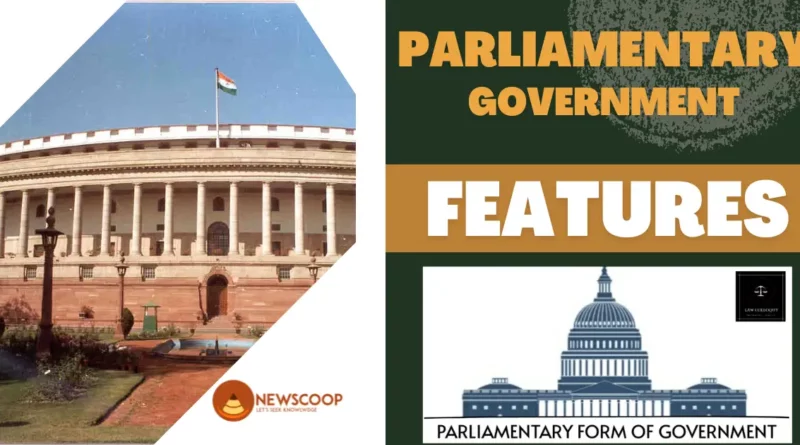Main Features of Parliamentary form of Government | UPSC
What is a Parliamentary form of Government?
The parliamentary form of government is a system of government in which the executive branch is accountable to the legislative branch, and in which the head of government (such as a Prime Minister or Chancellor) is appointed by the head of state (such as a President or Monarch) on the recommendation of the legislative body. In this system, the executive branch (made up of the Prime Minister and Cabinet members) is a part of the legislative branch and is responsible to it for its actions and policies. If the legislative branch (such as a parliament) passes a vote of no confidence in the government, the government must resign or call for new elections.
Features of Parliamentary form of Government
The following are the main feature of the Parliamentary form of government:
- Fusion of Executive and Legislative power
- Responsible Government
- Collective Responsibility
- Presence of an Opposition
- Role of Political Parties
- Head of State
- Flexibility
- Regular Elections
- Separation of Powers
- Constitutions
1. Fusion of Executive and Legislative Power
In the parliamentary form of government, the executive branch is accountable to the legislative branch. The Prime Minister, who is the head of government, is a member of the legislature and is appointed by the head of state on the recommendation of the legislative body. The Prime Minister and the Cabinet are responsible for the administration of government and are appointed by the head of state on the recommendation of the Prime Minister. This fusion of executive and legislative power allows for a more efficient government, as the Prime Minister and Cabinet can quickly respond to the needs of the legislature.
2. Responsible Government
The Prime Minister and the Cabinet are responsible to the legislative body for their actions and policies. They must answer questions and provide explanations for their actions in the legislature. If a vote of no confidence is passed, the government must resign or call for a new election. This ensures that the government is accountable to the people and can be removed if it is not fulfilling its responsibilities.
3. Collective Responsibility
The Cabinet is collectively responsible to the legislative body for its actions. If a member of the Cabinet disagrees with a policy decision, they are expected to resign from the Cabinet. This ensures that the Cabinet speaks with one voice and that all members are committed to the policies of the government.
4. Presence of an Opposition
In a parliamentary type of government, the opposition is always the party or coalition that does not have a majority of seats in the legislative body. The opposition is crucial in holding the government’s response by challenging its actions and policies and suggesting alternatives.
5. Role of Political Parties
Political play a crucial role in the parliamentary form of government as they nominate candidates for office and organize the legislative agenda. Political parties are the primary means through which citizens participate in the political process and are essential for the functioning of a parliamentary system. They provide a platform for citizens to organize and express their views, and they help to ensure that the government is responsive to the needs of the people.
6. Head of State
The head of state, typically a Monarch or President, has a ceremonial role and does not have executive powers. The head of the state’s main function is to represent the nation and its unity, but they may also have some powers such as appointing the Prime Minister, signing laws passed by the parliament, and granting pardons.
7. Flexibility
The parliamentary style of governance provides for quick decision-making and adaptability to changing conditions. The government can adapt to changing events more swiftly, and legislation can be approved with greater speed and efficiency.
8. Regular Elections
There are regular elections held in a parliamentary form of government, typically every few years, in which citizens can vote for their representatives. This allows citizens to hold their representatives accountable and to change the government if they are dissatisfied with its performance.
9. Separation of Powers
The parliamentary system of government assures that the executive, legislative, and judicial branches have distinct authorities. The executive is in charge of enforcing laws and policies, the legislative is in charge of establishing laws, and the judiciary is in charge of interpreting the laws and the constitution. This division of powers keeps any one arm of government from becoming too dominant and keeps the government’s response to the people.
10. Constitutions
Most parliamentary systems have a written constitution that lays out the basic principles and institutions of government, and the rights and responsibilities of citizens. This constitution serves as a fundamental law that limits the powers of government and protects the rights of citizens.
Also Read: Direct Democracy
Overall, the parliamentary form of government is a flexible and responsive system that allows for swift decision-making, regular elections, and separation of powers, while ensuring that the government is accountable to the people. It also allows for the presence of opposition, which is important in democratic societies as it holds the government accountable.
Conclusion
In Conclusion, the parliamentary system of government is a democratic one in which the legislative branch holds the executive branch responsible. It has a combination of legislative and executive authority, responsible administration, shared accountability, a place for the opposition, political parties, a ceremonial head of state, flexibility, regular elections, and separation of powers.
In addition, the majority of parliamentary systems also have written constitutions that outline the fundamental tenets and institutions of governance as well as the duties and rights of people. Further, the parliamentary system of governance ensures that the government is responsible to the people while also allowing for quick decision-making. In many nations across the world, it is a frequently employed system of governance.
So, this is all about the Main Features of the Parliamentary form of Government for UPSC. If you like this article, please share it with your friends.
Thank You!

